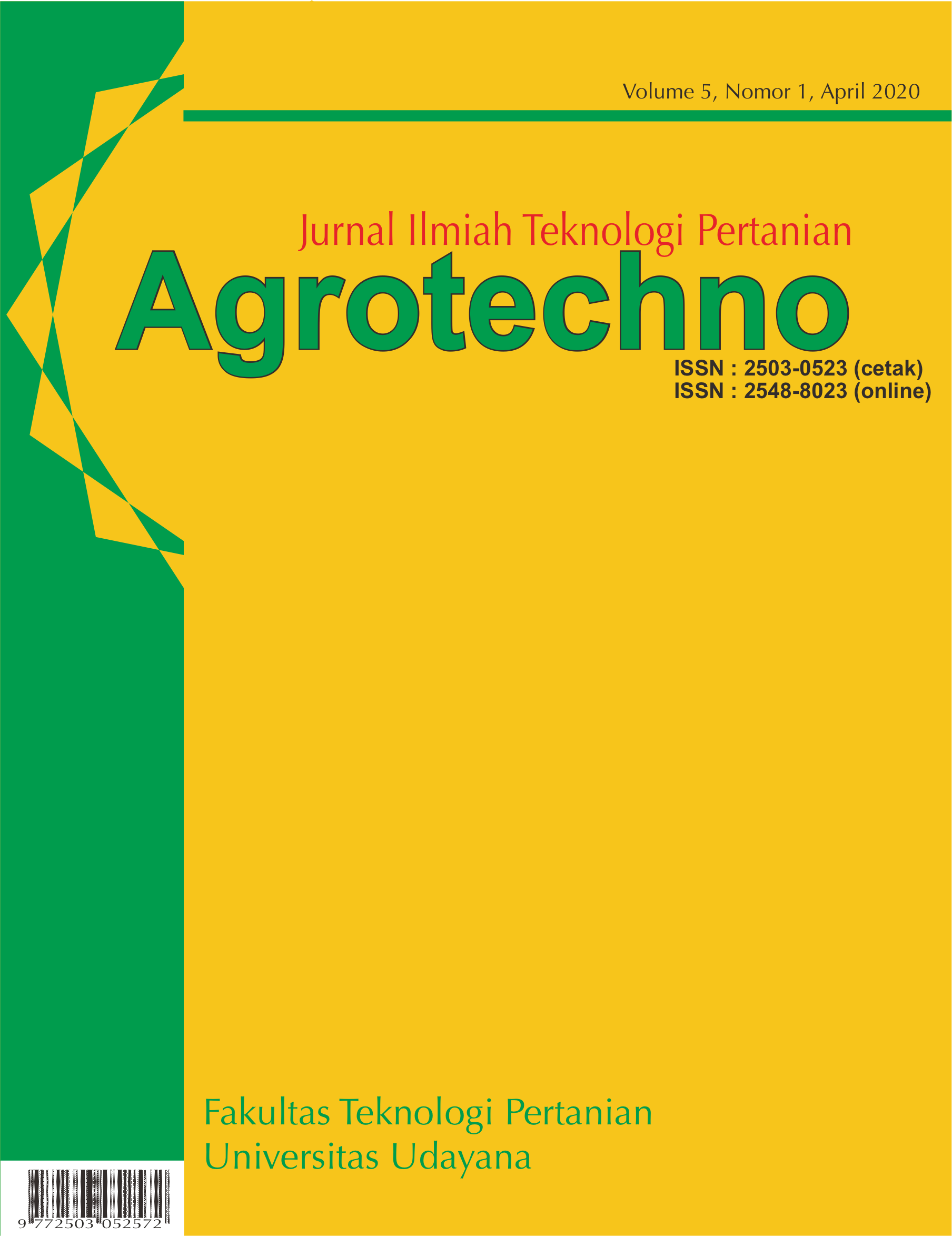Karakteristik Krim Kunyit Daun Asam (Curcuma domestica Val. - Tamarindus indica L.) pada Perlakuan Konsentrasi Emulsifier dan Waktu Pengadukan
Abstract
This study aimed to know cream of turmeric tamarind leaves on the treatment of concentration emulsifier and stirring time and to determine the concentration emulsifier and stirring time to produce characteristics of cream fulfill requirement of SNI. This study used a randomized block design with two factors. The first factor was the concentration emulsifier which consist of three levels, namely 3, 5 and 7%. The second factor is stirring time which consist of three levels, namely 5, 7.5 and 10 minutes. The data were analyzed by analysis of variance (ANOVA) and continued with the tukey test. The result of the study showed that concentration emulsifier has an effect on the adhesion time, pH, viscocity and spread power. The stirring time has an effect on the adhesion time. Concentration emulsifier 5% and 7% with stirring time 10 minutes were creams that fulfill requirement of SNI. The characteristics cream of concentration emulsifier 5% with stirring time 10 minutes is: homogeneus, separation ratio = 1, adhetion time 48.52 seconds, viscocity 3550 cp, spread power 6.72 cm and pH 6.60. The characteristics cream of concentration emulsifier 7% with stirring time 10 minutes is: homogeneus, separation ratio = 1, adhetion time 28.82 seconds, viscocity 3650 cp, spread power 6.79 cm and pH 6.45.
Downloads
References
Ansel, H.C. 2008. Pengantar Bentuk Sediaan Farmasi, Edisi Keempat. Penerjemah Farida Ibrahim. UI Press, Jakarta.
Bakkara, A., I.K. Satriawan and S. Mulyani. 2017. Stability of emulsion cream extract turmeric (Curcuma domestica Val.) in various concentration. J. Biol. Agric. and Health care. 7(2):93-99.
Devi, I.G.A.S.R. 2019. Pengaruh Nilai Hydrophile-Liphophile Balance (HLB) dan Jenis Ekstrak terhadap Karakteristik Krim Kunyit-Lidah Buaya. Skripsi. Tidak dipublikasi. Fakultas Teknologi Pertanian Unud, Bukit Jimbaran.
Flanagan, J. dan H. Singh. 2006. Microemulsions: a potential delivery system for bioactive in food. J. Crit. Rev. in Food Sci. Nut. 46(3):221-237.
Lieberman, H.A., M.M. Rieger and G.S Banker. 1996. Pharmaceutical Dosage Forms : Disperse System. 1st Edition. Marcel Dekker Inc., New York.
Maiti, R., D. Jana, U.K. Das and D. Ghosh. (2004). Antidiabetic effect of aqueous extract of seed of Tamarindus indica in streptozotocin-induced diabetic rats. J. Ethanopharmacol. 92(1):85-91.
Martin, A., J. Swarbrick dan A. Cammarta. 1993. Farmasi Fisik : Dasar-dasar Kimia Fisik dalam Ilmu Farmasetik. Edisi Ketiga. Jilid Kedua. Penerjemah Yoshita. UI Press, Jakarta.
Mulyani, S., B.A. Harsojuwono and A.A.G.P. Wiraguna. 2017. The potential of tumeric and tamarind leaves ekstract (Curcuma domestica Val.- Tamarindus indica L.) as anti-collagenase cream. J. Chem. Pharm. Res. 9(12):111-118.
Mulyani, S. and B.A. Harsojuwono. 2019. Antioksidant sinergisme of turmeric and tamarind leaf extracts (Curcuma domestica Val.- Tamarindus indica L.) in the linoleat system. J. of Agric. Hort. 21(2):140-145.
Mun’im, A., E. Hanani dan Rahmadiah. 2009. Karakterisasi ekstrak etanolik daun asam jawa (Tamarindus indica L.). Maj. Ilmu Kefarmasiaan. 6(1):38-44.
Natalie, A., S. Mulyani, dan B.A. Harsojuwono. 2017. Hubungan lama simpan dengan karakteristik mutu pada berbagai formulasi krim ekstrak kunyit (Curcuma dosmeticate Val). J. Rekayasa dan Manajemen Agroindustri. 5(4):21-30.
Pari, L., D. Tewas and J. Eckel. 2008. Role of curcumin in health and disease. J. Arch. of Physiol. Biochem. 114(2):127-149.
Purba, E.R. dan M. Martosupoyo. 2009. Kurkumin sebagai senyawa antioksidan. Prosiding Seminar Nasional Sains dan Pendidikan Sains. 4(3):607-621.
Schmitt, WH. 1996. Skin Care Products. In: Cosmetics and Toiletries Industry 2nd Edition. Williams, D.F. and W.H. Schmitt (Eds). Blackie Academic amd Profesional, London.
SNI, 16-4399-1996. 1996. Sediaan Tabir Surya. DSN, Jakarta.
Swastika, A.N.S.P., Mufrod dan Puwanto. 2013. Aktivitas antioksidan krim ekstak sari tomat (Solanum lycopersicum L.). J. Trad. Med. 18(3):132-140.
Syamsuni. 2006. Farmasetika Dasar dan Hitungan Farmasi. Kedokteran EGC, Jakarta.
Tranggono, R.I. dan F. Latifah. 2007. Buku Pegangan Ilmu Pengetahuan Kosmetik. PT. Gramedia Pustaka Utama, Jakarta.
Ulaen, S.P.J., Y. Banne dan R.A. Suatan. 2012. Pembuatan salep anti jerawat dari ekstrak rimpang temulawak (Curcuma xantborrbiza Roxb.). J. Ilmiah Farmasi. 3(2):45-49.
Winarsi, H. 2007. Antioksidan Alami dan Radikal Bebas. Kanisius, Yogyakarta.










